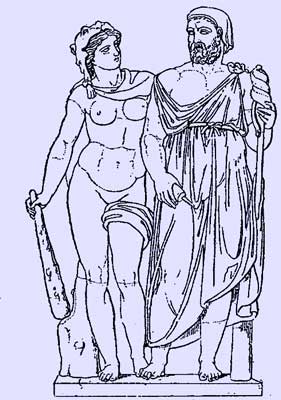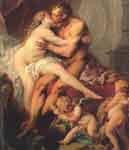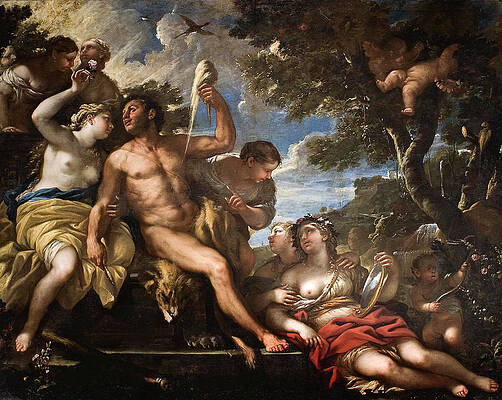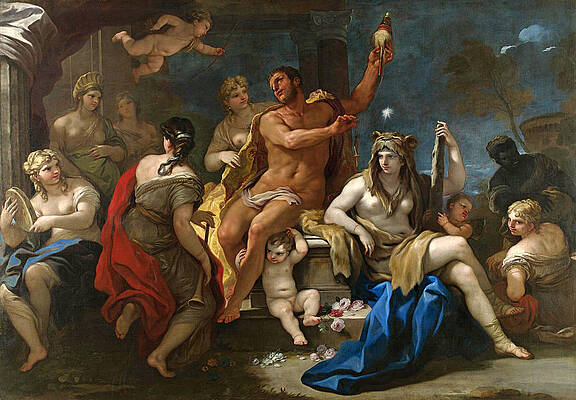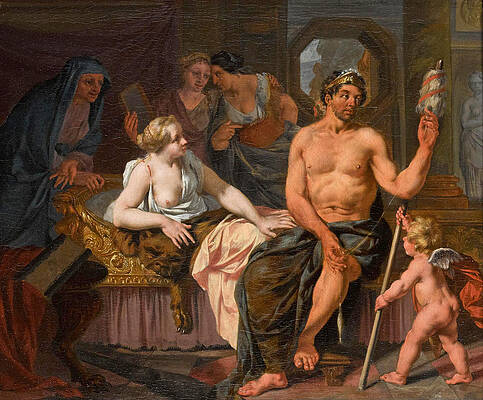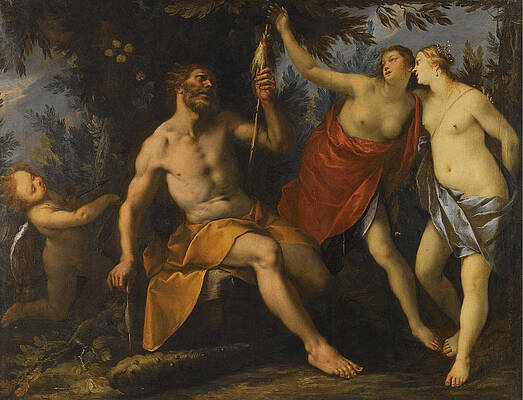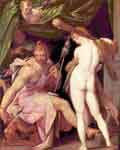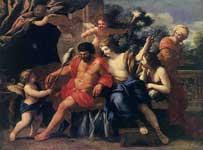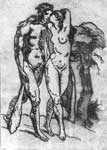.

Hercules and Omphale Detail of The Twelve Labours Roman mosaic from Llíria (Valencia, Spain). Flintstone. First half of the 3rd century. In the National Archaeological Museum of Spain (Madrid). It shows Hercules wearing women's clothing and holding a ball of wool (left), and Omphale wearing the skin of the Nemean Lion and carrying Hercules' olive-wood club (right).
In Greek mythology, Omphale (Ὀμφάλη) was a queen or princess of Lydia. As penalty for his murder of Iphitus, Heracles was, by Zeus' command, sold as a slave and Omphale became his purchaser.
Heracles and Omphale
Omphale was daughter of the river Iardanus (also called Iardanes). According to Apollodorus she was the widow of King Tmolus from whom she inherited the throne. There are many references in text and art to Heracles being forced to do women's work and even wear women's clothing and hold a basket of wool while Omphale and her maidens did their spinning. At times Omphale even wore the skin of the Nemean Lion and carried Heracle's olive-wood club. Unfortunately no full account survives.
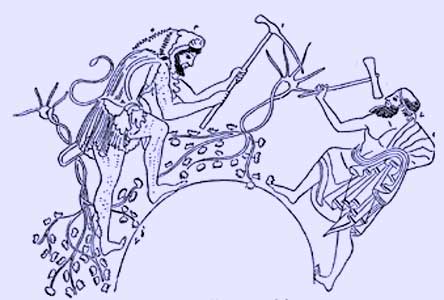
Heracles and Syleus
But it was also during his stay in Lydia that Heracles enslaved the Itones, killed Syleus who forced passersby to hoe his vineyard, and captured the Cercopes.
At some time during this stay Omphale freed Heracles and took him as her husband.
Omphale's name means Navel (i.e. axis), and may represent a significant Lydian earth goddess. Heracles' servitude thus represents the servitude of the sun to the axis of the celestial sphere, the spinners being Lydian versions of the Moirae. Most earth goddess religions contained a priesthood which wore women's clothing, was effeminate, or involved eunuchs. The priest of Herakles, curiously, also wore female clothing, and this myth may represent an attempt to explain the fact.
Sons of Heracles in Lydia
It would be expected that accounts should speak of at least one son born to Heracles by Omphale. It might also be expected that such accounts would not agree. Both expectations are spendidly fulfilled.
Diodorus Siculus (4.31.8) and Ovid in his Heroides (9.54) mention a son named Lamos. But Apollodorus (2.7.8) gives the name of the son of Heracles and Omphale as Agelaus.
Pausanias (2.21.3) gives yet another name, mentioning Tyrsenus son of Heracles by "the Lydian woman" by whom Pausanias presumably means Omphale. This Tyrsenus supposedly first invented the trumpet and Tyrsenus' son Hegeleus taught the Dorians with Temenus how to play the trumpet and first gave to Athena the surname Trumpet. The name Tyrsenus appears elsewhere as a variant of Tyrrhenus whom many accounts bring from Lydia to settle the Tyrsenoi/Tyrrhenians/Etruscans in Italy. Dionysius of Halicarnassus (1.28.1) indeed does cite a tradition that the supposed founder of the Etruscan settlements was Tyrrhenus the son of Heracles by Omphale the Lydian who drove out the Pelasgians of Italy from the cities north of the Tiber river. Dionysius gives this as an alternate to other versions of Tyrrhenus' ancestry.
Omphale and Heracles, Francois Lemyone, 1724
Hercules and Omphale , Francois Boucher
Herodotus (1.7) refers to a Heraclid dynasty of kings who ruled Lydia yet were perhaps not descended from Omphale. For what Herodotus writes is "The Heraclides, descended from Heracles and the slave-girl of Iardanus, ...". Omphale as slave-girl seems odd. However Diodorus Siculus relates that when Heracles was still Omphale's slave, before Omphale (daughter of Iardanus) set Heracles free and married him, Heracles fathered a son Cleodaeus on a slave-woman. This fits, though in Herodotus the son of Heracles and the slave-girl of Iardanus is named Alcaeus.
But according to the historian Xanthus of Lydia (5th century BCE) as cited by Nicholaus of Damascus, the Heraclid dynasty of Lydia traced their descent to a son of Heracles and Omphale named Tylon and were called Tylonidai. We know from coins that this Tylon was a native Anatolian god equated with the Greek Heracles.
Herodotus' genealogy seems confused in any case. Herodotus asserts that the first of the Heraclids to reign in Sardis was Agron, the son of Ninus, son of Belus, son of Agelaus, son of Heracles. But later writers know a Ninus who is the primordial king of Assyria and they often call this Ninus son of Belus. Their Ninus is the legendary founder and eponym of the city of Ninus, Greek Ninos, Latin Ninus, referring to Ninevah while Belus, though sometimes treated as a human, was obviously originally intended to be the god Bel. A simpler genealogy is likely to have made Agron, as a legendary first king of an ancient dynasty, to be a son of the mythical Ninus son of Belus and have stopped at that point. But in the genealogy given by Herodotus someone has rather stupidly stuck a son of Heracles followed by Heracles himself at the top end of it, so that Ninus and Belus in the list now become descendants of Heracles who just happen to bear the same names as the more famous Ninus and Belus.
That, at least is the interpretation of later chronographers who also ignored Herodotus' statement that Agron was the first to be a king and included Alcaeus, Belus, and Ninus in their List of Kings of Lydia. Thus does myth become legend and legend become purported history.
As to how Agron gained the kingdom from the older dynasty descended from Lydus son of Atys, Herodotus only says that the Heraclides: "... having been entrusted by these princes with the management of affairs, obtained the kingdom by an oracle."
Strabo (5.2.2) makes Atys father of Lydus and Tyrrhenus to be one of the descendants of Heracles and Omphale. This is likely careless error rather than independent tradition as all other accounts place Atys and Lydus and Tyrrhenus brother of Lydus among the pre-Heraclid kings of Lydia.
Omphale, Byam Shaw
Hercules and Omphale, Antonio Bellucci
Hercules at the feet of Omphale, Edouard Joseph Dantan
Hercules and Omphale, Luca Giordano
Hercules and Omphale, Luca Giordano
Hercules and Omphale, Nicolaas Verkolje
Hercules and Omphale, Francois Perrier
Hercules and Omphale, Giovanni Stefano Danedi
Hercules and Omphale, Bartholomäus Spranger c. 1600
Hercules and Omphale, Giovanni Francesco Romanelli
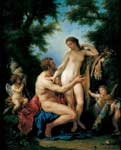
Hercules and Omphale, Louis-Jean-Francois Lagrenee
|
|
See also : Greek Mythology. Paintings, Drawings
| Ancient Greece
Science, Technology , Medicine , Warfare, , Biographies , Life , Cities/Places/Maps , Arts , Literature , Philosophy ,Olympics, Mythology , History , Images Medieval Greece / Byzantine Empire Science, Technology, Arts, , Warfare , Literature, Biographies, Icons, History Modern Greece Cities, Islands, Regions, Fauna/Flora ,Biographies , History , Warfare, Science/Technology, Literature, Music , Arts , Film/Actors , Sport , Fashion --- |
Retrieved from "http://en.wikipedia.org"
All text is available under the terms of the GNU Free Documentation License

